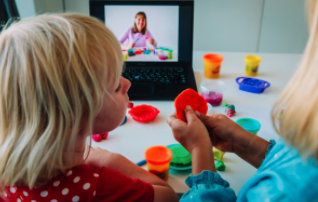Children can quickly lose their sense of community and connection while in isolation. School has always been a consistent source of social connection and support for kids. When that feeling of connection is gone, a kid’s social and emotional health can suffer. Creating connections for children—helping them not feel alone—is important for them developmentally and emotionally. But how do we do this in a safe way? How can parents take the lead on creating connections for their child when school isn’t in-person? We know that every situation is unique during this time, but we wanted to offer some ideas to parents that may help.
-
Work With Your Child’s School
Advocate to your school leaders for community-building practices in remote learning. Schools can build on and adapt activities that were already happening on campus. For example, continuing spirit weeks, planning social zoom hours or lunch meetings, and having a small-group advisory. Getting your school’s support will help take all the burden off of you as parents! You can also ask your child what they would like to see in terms of social connection with their classmates and share their opinion with the school. What would your child like to do with other people? Ask them and try to make it happen safely with the school or in other ways at home!
-
Online Play Dates
Informal online playdates help kids see their friends and keep those important peer relationships intact. Although this doesn’t help with lowering screen time, there are a lot of different collaborative online games. A lot of my former middle school students would spend entire weekends playing games with friends online even before COVID. Video chatting or video “play” is another great idea. Kids can get really creative with this. A friend’s young daughter plays dress-up and “let’s pretend” with her friends on her iPad. There are also online field trips, virtual online communities—like outschool—that allow them to meet new friends, blog sharing with family and friends, and even scheduling social zoom lunches either on your ow n or with the teacher’s help.
n or with the teacher’s help.
Here are some resources that may be helpful:
- Collaborative online games
- Virtual “field trips”
- Join a virtual online community
- Start writing their own blog
-
Create a Trusted Circle of Friends
If you have friends with whom you are aligned on safety and risk, you can create a “bubble”—a select group of 12 people who only hang out with each other. I’ve read from a few sources that this is a fairly safe method if families are committed to the bubble, but there is still risk involved. This is definitely a decision that requires intentional reflection about risk versus reward and a delicate conversation with friends, but some families have decided to take the risk for their children’s social-emotional health.
-
Get Outside
Depending on your comfort level, this could be just getting outside with family or a few close trusted friends. Walks, bike rides, outdoor picnics or barbeques, and scavenger hunts/obstacle courses are all good ways to be social outside. Here are a few ways to help your child get outside:
-
Socialize Within Your Family
Having trouble entertaining your kids? This is a great time to connect with the extended family unit. What ways can your kids get creative together? And how can you spark competition between family members in a joyful way? I’ve heard ideas like joint-family Netflix-viewing parties, starting new hobbies together, kid dance performances with parent audiences, writing a family newsletter, virtual cook-offs, theme parties, and camping out in the backyard. Now that it’s fall, pitch a tent inside! Time each other and see who can do it the fastest.
And there’s nothing like family dinner to forge a sense of connection. Here are some ideas for conversation topics at the table: Fun family conversation starters with kids. What a silver lining it would be if the pandemic brought your family closer!
-
Check In with Loved Ones as Much as Possible
Staying connected to loved ones when there’s physical distance can help children feel less lonely and isolated. Ways to connect include phone calls, emails, letters or postcards, video chat, COVID-safe care packages, or downloading communication apps.
-
Commit Acts of Service and Kindness
Helping others helps kids appreciate their own situations, improve mental health, and connect with other people. Write letters to people you know who are essential workers. Find ways to donate time or funds to organizations or people in need, call a neighbor who is alone to give them some company. Acts of goodwill demonstrate kindness and build gratitude and connection during tough times.
Reach out to amanda@possip.com to talk more about this topic!





